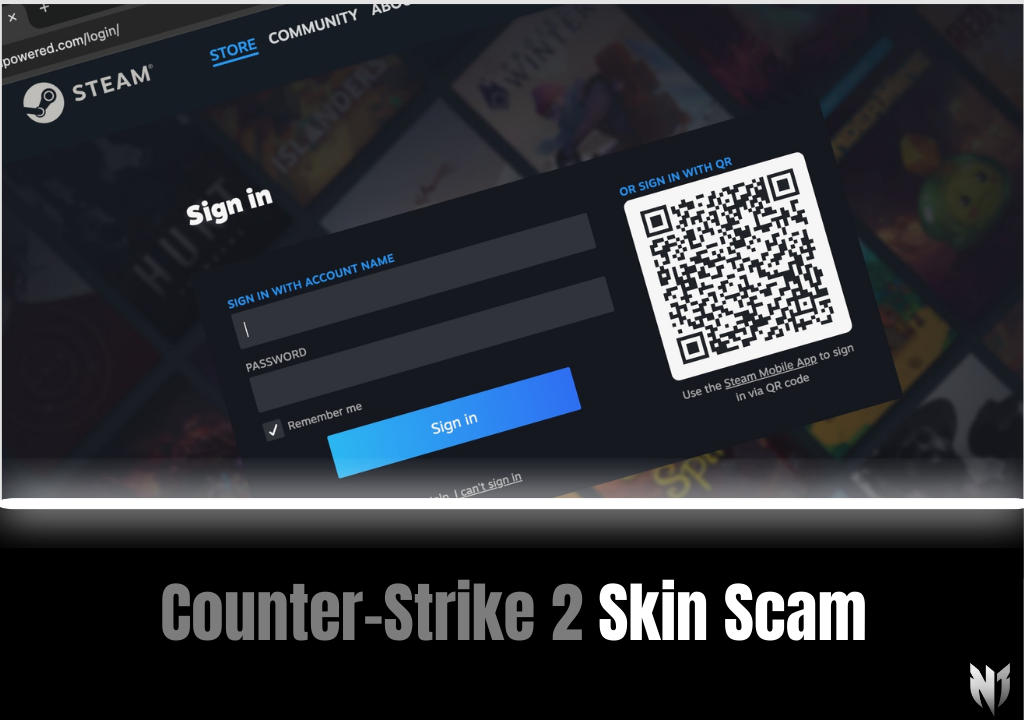Counter-Strike 2 Skin Scam: Hackers Use Fake Pop-Ups to Steal Accounts
Counter-Strike 2 players are being targeted by a new browser-based phishing scam that steals Steam credentials and skins worth thousands of dollars. Here’s what you need to know to protect yourself.
How the Scam Works: Fake Pop-Ups and Phishing Attacks
A newly discovered scam is tricking CS2 players into handing over their Steam login information using a method known as a browser-in-browser attack. This exploit creates an in-browser window that mimics the official Steam login prompt, fooling players into entering their credentials.
According to cybersecurity researchers at Silent Push, these pop-ups are so realistic that even the URL looks legitimate, making it nearly impossible to tell the difference at a glance. Once logged in, hackers instantly hijack the account and steal all in-game assets—especially skins, which can be resold for serious profit.
Hackers Imitate Esports Brands to Lure Victims
One of the most convincing elements of this scam is the use of fake esports branding. In several cases, attackers pretended to be members of Natus Vincere (NaVi), one of the most iconic teams in Counter-Strike history. Campaigns like “Play Like Navi” promised free skins or private server access in exchange for login details, but the result is account theft and locked access.
Why Counter-Strike 2 Skins Are Prime Targets
The CS2 skin economy is one of the most valuable ecosystems in all of gaming. With skins like the AK-47 Case Hardened or AWP Dragon Lore selling for thousands of dollars, accounts with premium cosmetics are highly attractive targets for cybercriminals. Some of these skins are even used as currency on grey-market gambling sites and crypto exchanges.
The value of a single CS2 inventory can easily surpass $10,000, making it a goldmine for hackers using phishing tools to infiltrate accounts.
How to Protect Your CS2 Account from Hackers
Here are the most effective ways to safeguard your Counter-Strike 2 account:
- Test Pop-Ups for Authenticity: Try dragging the Steam login pop-up. A fake window can’t be moved outside the browser. If it’s “locked” in place, it’s a scam.
- Enable Steam Guard: Always activate Multi-Factor Authentication through the Steam Mobile App to block unauthorized access, even if your password is compromised.
- Avoid “Free Skin” Offers: Promotions that require external login or offer rare skins for free are almost always scams. Stick to official CS2 or Steam events.
- Monitor Account Activity: Regularly check for unknown logins, trades, or suspicious inventory changes. Report anomalies to Steam Support immediately.
- Use Trusted Platforms: Only trade on verified community platforms with high Trustpilot scores. Avoid shady marketplaces that don’t verify accounts or items.
Valve’s Response to the Threat
While Valve hasn’t issued an official statement at the time of writing, Silent Push confirmed that the scam primarily affects desktop users. Mobile players are less likely to be affected, as the fake login windows are designed for large screen resolutions.
Steam’s native protections are strong, but players must take proactive steps to secure their accounts. Valve frequently updates its backend security systems, but individual awareness is still the first line of defense.
Staying Safe in CS2’s Growing Ecosystem
As Counter-Strike 2 continues to rise in popularity, so does its vulnerability to cyber threats. If you value your inventory and progress, now is the time to double down on your security. Never share your credentials, and avoid downloading suspicious files or clicking unknown links.
And remember—skins don’t win games. If you’re looking to rank up without taking risks, our CS2 Premier Boosting and CS2 Rank Boosting services offer safe, professional support from elite players.
Final Thoughts
Don’t let hackers steal what you’ve earned. Stay secure, stay smart, and always verify what you click. And when you're ready to dominate in ranked—let N1Boost guide the way.



